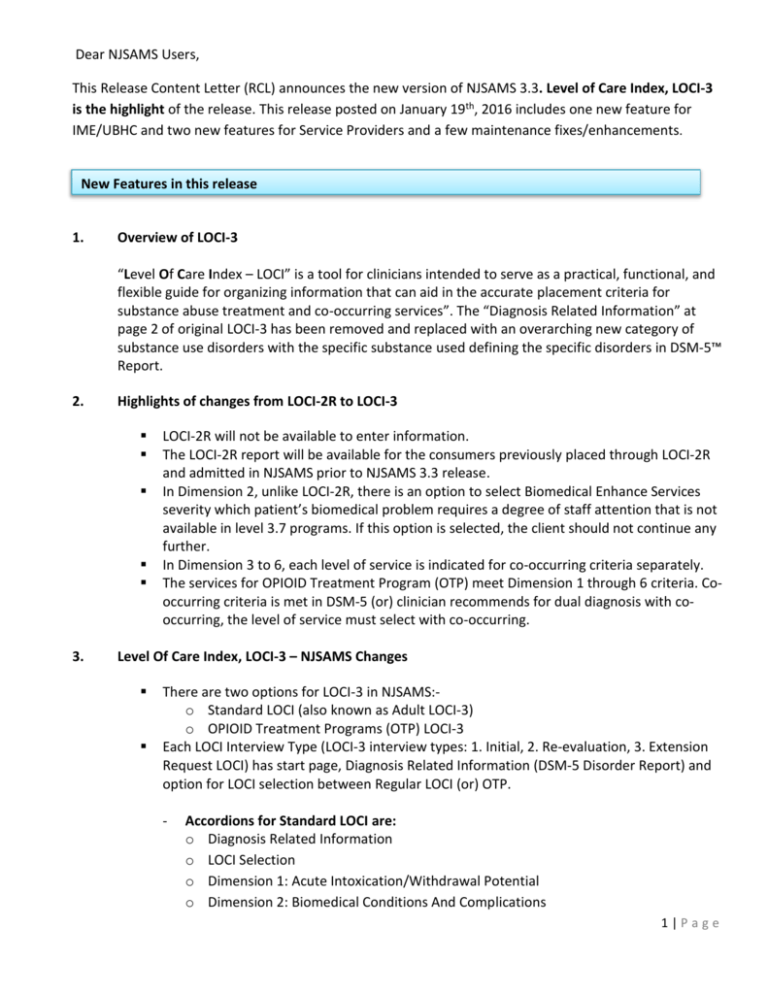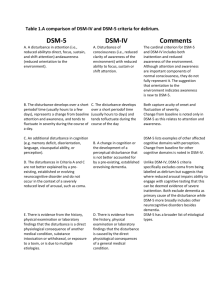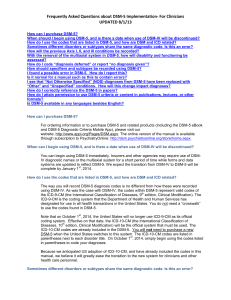NJSAMS 3.3 Release Notes
advertisement

Dear NJSAMS Users, This Release Content Letter (RCL) announces the new version of NJSAMS 3.3. Level of Care Index, LOCI-3 is the highlight of the release. This release posted on January 19th, 2016 includes one new feature for IME/UBHC and two new features for Service Providers and a few maintenance fixes/enhancements. New Features in this release 1. Overview of LOCI-3 “Level Of Care Index – LOCI” is a tool for clinicians intended to serve as a practical, functional, and flexible guide for organizing information that can aid in the accurate placement criteria for substance abuse treatment and co-occurring services”. The “Diagnosis Related Information” at page 2 of original LOCI-3 has been removed and replaced with an overarching new category of substance use disorders with the specific substance used defining the specific disorders in DSM-5™ Report. 2. Highlights of changes from LOCI-2R to LOCI-3 3. LOCI-2R will not be available to enter information. The LOCI-2R report will be available for the consumers previously placed through LOCI-2R and admitted in NJSAMS prior to NJSAMS 3.3 release. In Dimension 2, unlike LOCI-2R, there is an option to select Biomedical Enhance Services severity which patient’s biomedical problem requires a degree of staff attention that is not available in level 3.7 programs. If this option is selected, the client should not continue any further. In Dimension 3 to 6, each level of service is indicated for co-occurring criteria separately. The services for OPIOID Treatment Program (OTP) meet Dimension 1 through 6 criteria. Cooccurring criteria is met in DSM-5 (or) clinician recommends for dual diagnosis with cooccurring, the level of service must select with co-occurring. Level Of Care Index, LOCI-3 – NJSAMS Changes There are two options for LOCI-3 in NJSAMS:o Standard LOCI (also known as Adult LOCI-3) o OPIOID Treatment Programs (OTP) LOCI-3 Each LOCI Interview Type (LOCI-3 interview types: 1. Initial, 2. Re-evaluation, 3. Extension Request LOCI) has start page, Diagnosis Related Information (DSM-5 Disorder Report) and option for LOCI selection between Regular LOCI (or) OTP. - Accordions for Standard LOCI are: o Diagnosis Related Information o LOCI Selection o Dimension 1: Acute Intoxication/Withdrawal Potential o Dimension 2: Biomedical Conditions And Complications 1|Page o o o o o o o - Dimension 3: Emotional, Behavioral, Or Cognitive Conditions And Complication Dimension 4: Readiness To Change Dimension 5: Relapse, Continued Use, Or Continued Problem Potential Dimension 6: Recovery Environment Level of Care Summary of Findings LOCI3 Evaluations History Extension Request LOCI (appears when applicable only) Accordions for OTP LOCI are: o Diagnosis Related Information o LOCI Selection o OPIOID Treatment Programs (OTP) – LOCI - Dimension 1 through Dimension 6 o Level of care Summary of findings o LOCI3 Evaluations History o Extension Request LOCI (appears when applicable only) If the consumer has completed DASIE Registration, Immediate Need Profile (INP), UNCOPE (optional), Income Eligibility /Program Eligibility (IE/PE) and DSM-5, the link for LOCI-3 will appear under “Clients Quick Links” at left navigation. Counselor name, LOCI Evaluation Date and Supervisor Name are mandatory and Credential (multiple selections are available to enter) is optional. A new LOCI-3 Report. Ability to view LOCI-3 Report for initial, re-evaluation and Extension Request by IME. Note: Implementation of LOC-3 in NJSAMS is referred from 2013 publication of Level Of Care Index, LOCI-3 by Norman G. Hoffmann, Ph.D., David Mee-Lee, M.D., & Gerald D. Shulman, M.A., M.A.C., FACATA 4. DSM-5 History/ Re-evaluation (or) Versioning Adding “Re-evaluations” accordion in DSM-5. In the display, there are columns for DSM ID, Counselor Name, DSM Evaluation Date, Primary Diagnosis and Report. Click on Report to retrieve DSM-5 report for initial and re-evaluation report. Under the DSM-5 History, there are two buttons for “Re-evaluation DSM-5” and “DSM-5 Report” for current DSM-5. Ability to view history of evaluations for the client within an agency. DSM-5 history from another agency for the same client cannot be viewed by current agency. Benefit to adding DSM-5 re-evaluation is to allow changes/corrections of DSM-5 information regarding client’s progress in the treatment process after review by licensed clinical supervisors (or) clinicians. Keeping track of the clients’ changes in status by comparing diagnosis. 2|Page Maintenance Fixes and Enhancements in this release 5. DUII Eligibility 6. This fix ensures DUII eligibility if the conviction is after October 17, 2005. Currently, user has to select the conviction date if the client has multiple convictions. In this release, the system will automatically track on the last conviction date and the referring IDRC County. Client must have conviction date on or after October 17, 2005. The client Federal Poverty Level (FPL) calculated in DASIE must be less than 350%. If the client is eligible for DUII Initiative, request assessment authorization by referring (or) requesting to IME. If the client is eligible for DUII, IME can secure assessment authorization and issue to service provider. If the client is Medicaid Recipient IME will deny issuing assessment authorization funded by DUII Initiative. Admission and Discharge Validation Age at first use must not be older than the client’s current age at the admission Validation on Primary, Secondary and Tertiary drug cannot be the same drug in admission. Validation on Primary, Secondary and Tertiary drug cannot be the same drug in discharge. If the age at first use is less than 7 years of age, or more than the client’s current age the message pop-up for correction Brian G. Regan Assistant Director Office of Information Systems (OIS) Division of Mental Health and Addiction Services 3|Page









